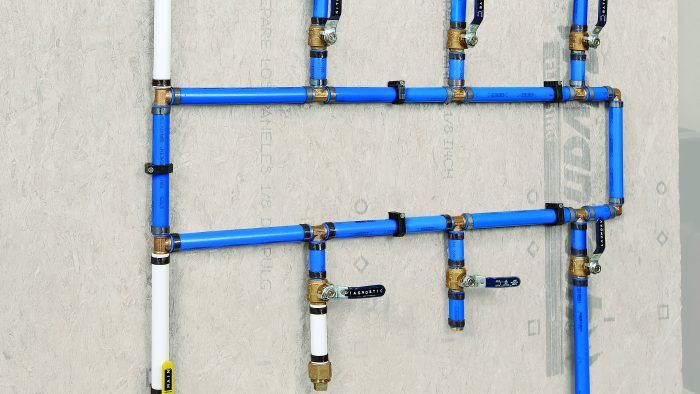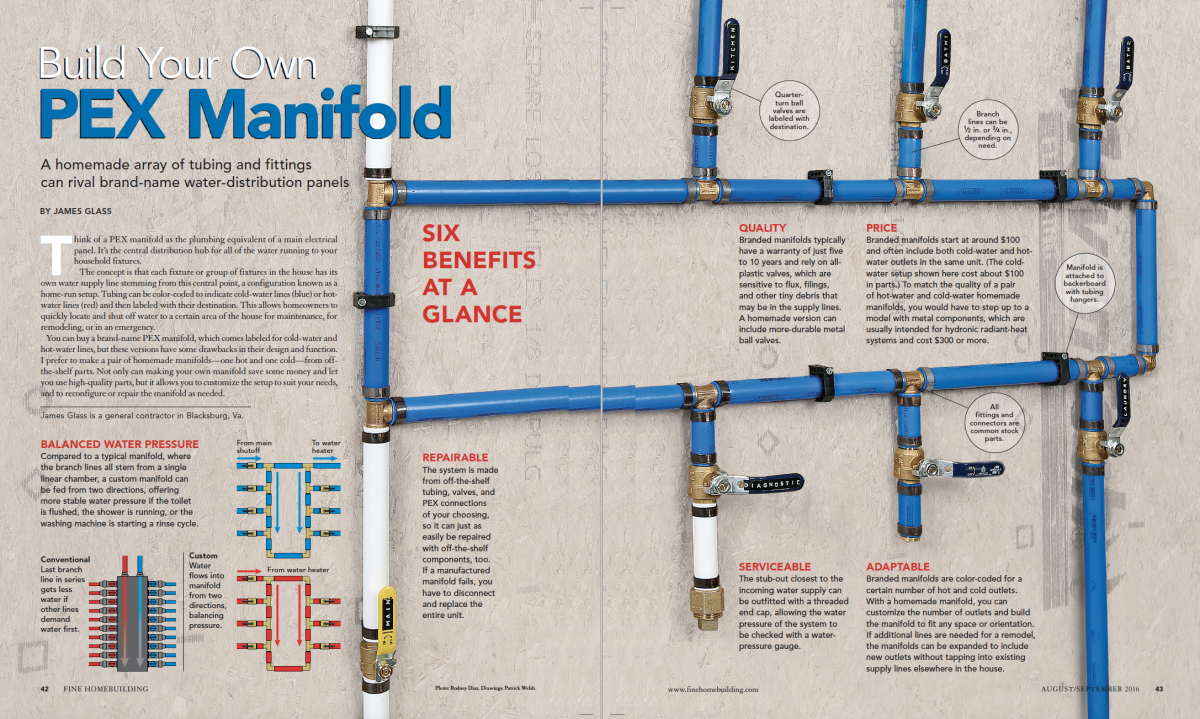Build Your Own PEX Manifold
A homemade array of tubing and fittings can rival brand-name water-distribution panels.

Synopsis: A centrally located distribution block for your entire plumbing supply system, a manifold makes installation easier and emergency shutoffs faster. Manifolds can be purchased, but there are clear advantages to building your own from off-the-shelf parts, as outlined in this article.
Think of a PEX manifold as the plumbing equivalent of a main electrical panel. It’s the central distribution hub for all of the water running to your household fixtures. The concept is that each fixture or group of fixtures in the house has its own water supply line stemming from this central point, a configuration known as a home-run setup. Tubing can be color-coded to indicate cold-water lines (blue) or hot-water lines (red) and then labeled with their destination. This allows homeowners to quickly locate and shut off water to a certain area of the house for maintenance, for remodeling, or in an emergency. You can buy a brand-name PEX manifold, which comes labeled for cold-water and hot-water lines, but these versions have some drawbacks in their design and function. I prefer to make a pair of homemade manifolds—one hot and one cold—from off-the-shelf parts. Not only can making your own manifold save some money and let you use high-quality parts, but it allows you to customize the setup to suit your needs, and to reconfigure or repair the manifold as needed.
Six benefits at a glance
Balanced Water Pressure: Compared to a typical manifold, where the branch lines all stem from a single linear chamber, a custom manifold can be fed from two directions, offering more stable water pressure if the toilet is flushed, the shower is running, or the washing machine is starting a rinse cycle.
Repairable: The system is made from off-the-shelf tubing, valves, and PEX connections of your choosing, so it can just as easily be repaired with off-the-shelf components, too. If a manufactured manifold fails, you have to disconnect and replace the entire unit.
Quality: Branded manifolds typically have a warranty of just five to 10 years and rely on all-plastic valves, which are sensitive to flux, filings, and other tiny debris that may be in the supply lines. A homemade version can include more-durable metal ball valves.
Price: Branded manifolds start at around $100 and often include both cold-water and hot-water outlets in the same unit. (The cold-water setup shown here cost about $100 in parts.) To match the quality of a pair of hot-water and cold-water homemade manifolds, you would have to step up to a model with metal components, which are usually intended for hydronic radiant-heat systems and cost $300 or more.
For more photos and details, click the View PDF button below:







View Comments
I disagree with the article. Firstly, As I type this anyone can get a solid copper manifold with six copper ball valves for $70 which is, I think, cheaper than eight tees, two quarter turns, and six ball valves. (http://www.supplyhouse.com/Sioux-Chief-672XV0690-PEX-Manifold-3-4-PEX-x-Spin-Closed-Trunk-1-2-PEX-Ball-Valves-6-Outlets).
Secondly, plumbing almost always leaks at the joints and with 40 joints in there instead of 7 for a copper manifold it doesn't make sense either.
Lastly, the I.D. of a 1/2" PEX fitting is close to 3/8" so even if you branch off the trunk twice you aren't getting nearly the flow you could get out of a 1" sweat manifold (a valved 8 port 1" sweat manifold is $87 for the record). If you are worried about pressure loss then you can cut of the spun closed end and connect it back into your trunk.
Most of the modern manifold are 3/4 inch feed a 1 or 2 inches manifold with 1/2 inches outlets that balance water pressure ,1/2 pex got a small id compare to 1/2 copper who is much closer to 1/2 inch, on a pex line should always run to its taps without couplings a straight through connector adaptor if you don't want your water pressure down , did that mistake once connected a shower head with 1/2 inch pex the balance tap didn't work anymore found out in the instructions later that even on a pex line the between the shower head and the tap it's got to be absolutely copper conduct ..the rest in pex..